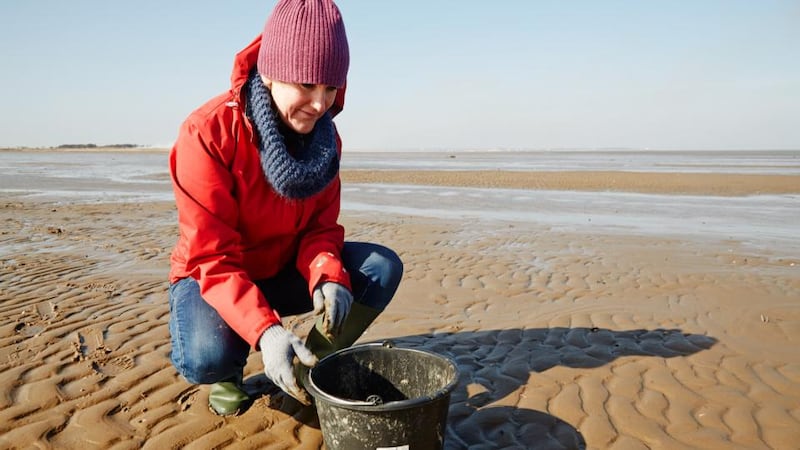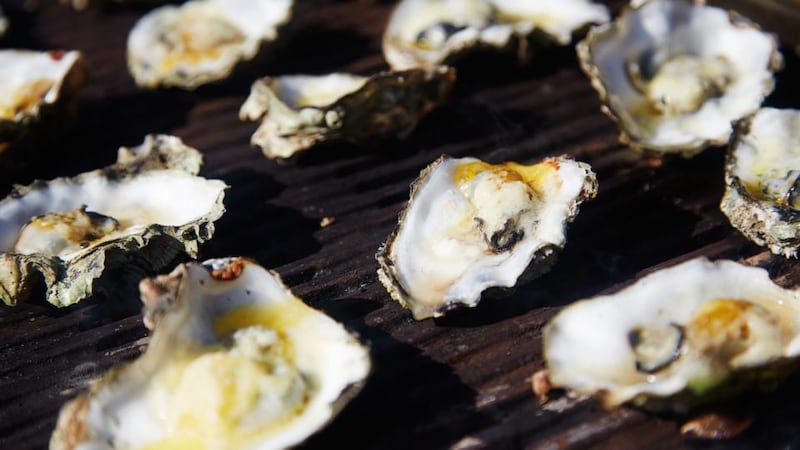Scanning the damp sand on a beach in a stiff wind doesn’t sound like much fun, but it’s oddly thrilling. I’m looking for barnacled ridges; when you see one you hunker down and edge a finger under it. If it comes up easily it’s an empty half shell or a tiddler. If you need to prise it out of the suck of the sand – then you’ve hit the mother-load. Later I’ll discover that these enormous wild oysters that are so satisfying to find are almost impossible to open. It feels like trying to shuck a rock. But at the moment it’s all about the thrill of hunting and gathering lunch. And a race to see who’s going to bring the heaviest bucket back to the barbecue.
We’re on the eastern side of Fano, which is an island that sits a twelve-minute ferry ride off the west coast of Denmark. In summer the population swells from 3,600 to over 30,000 as the Danish and German tourists come to holiday here. Today it’s low season, and the Danish Food project is showing journalists what they offer to the gastronomic tourist, (a growing breed of European traveller) who wants to get under the skin of a country through its food.
Fano is a curious and beautiful place at this time of the year, bathed in pearl grey sunlight. The island is covered in quaint Dutch-style houses, a legacy from over than three hundred years ago when the King of Denmark sold Fano to it’s inhabitants. The tiny independent republic began a lucrative sea trade with Holland.


Fano is now Danish again and the ‘Hamptons’ of Copenhagen, a place where city dwellers go to their beautifully preserved summer houses. Musicians and artists come here to work, staying in specially equipped houses to sing, write or paint. A bridge was once mooted to connect the island to the mainland but the islanders resisted the idea. In September they host what they claim is the world’s biggest knitting festival.
Outside uber-cool Copenhagen parts of rural Denmark are reassuringly hick. On the train back to the capital – I photograph the name of a town we pass through– Middelfart is too good a name to let slide past the window unrecorded.
On Fano, the Pacific Gigas oysters are invaders, our guide Jesper Voss explains. They think the oysters grew from stowaway seed oysters in the ballast water of a cargo ship as soon as the sea temperature was warm enough for them to thrive. Now they’re eating the food of the native mussels and clams. Further up the food chain the 12 million migrating birds which feed on those mussels and clams before their arduous onward journeys are threatened. Their beaks are not strong enough to break through the oysters’ tough shells.
Back in the dunes the idea of doing a service to seabirds adds to the fun of slurping these wild interloper oysters with lemon juice or barbecuing them slowly in their own brine. The world’s largest oyster was recently found here – a monster the size of a large man’s shoe. Its living out its days in the Wadden Sea Centre on the mainland. In a typical fisherman style Jesper Voss says he’s seen larger.
The Danish food revolution has reached the island with food and drink businesses now providing year-round work. Edit and Niels Rudbeck are a couple who turned their cheese shop into a deli and cafe three years ago. They met at farm school, Edit explains – she was one of five women in a class of 150 men. “We know how and when to make good food,” she says simply. Their butter, mustard and marmalade are all home-made. We feast on a typical Danish open sandwich: ryebread piled high with tasty things: the locally-smoked Fano salmon, shrimp from the Wadden sea and local cheeses and rullpolse, (a spiced pork belly roll).
The sausage comes from the nearby butcher, Henrik Christiansen. His most famous product is the distinctive Fano ham, a flat treacle-black cured and smoked ham. They bone the pork legs by hand, he explains, a process that takes some serious amounts of arm strength. Then the meat is spiced and salted for five weeks before being dried and smoked. He wanted the ham to look like something his grandmother would have hung in her chimney. When we tour the butchers, we see Irish beef being turned into sausages which are then sold all over the country.
Then it’s over to the Fano Brewery, one of around 120 small breweries that have sprung up all over Denmark in the last decade. Its owner Claus Winther has a flint-dry sense of humour.
He brews beer for Noma through the Evil Twin Brewing company. The first was an oxalis beer, the second juniper and the third “is a secret”. His new brewer is a bearded American called Michael Romeo who on a tour of Danish brewers. It hasn’t been a huge leap to move from his tiny mountain town near Denver to this tiny island, Romeo says. “The water is amazing.” And the downsides? “They would probably be getting things shipped here.”
What’s the weirdest beer he’s ever tasted? “Rocky Mountain oyster beer,” he says, (a Rocky Mountain oyster is a bull’s testicle).
That night we sleep in The Shire, otherwise known as the Sonderho Kro, the main Inn in Fano’s tiny capital, a crooked cosy fairytale place with twenty comfortable rooms and a chef – Jakob Sullestad – who teams lumpfish roe with egg and cress and turbot with chicken skin, beet and chervil.
Before we leave Fano we tick off another favourite beach activity – sail carting on the firm wet sand using that island wind to go faster than you feel you should. The technique sounds simple: you sit in a low three-wheeled cart with a small windsurfing-type-sail attached. You steer the front wheel with your feet and pull the rope on the sail to increase the speed.
All fine in theory.
But on a windy day it feels like being put behind the wheel of a car and having a breeze block dropped on the accelerator. My instinct is to pull on the rope, which of course makes everything speed up even more. I’m quaking at the knees when I stand up after digging my heels into the sand to make it stop.
“I want one of those,” the twenty-something Danish photographer says with a face-splitting grin as he clambers out of his sail cart. Rather him than me. As sand thrills go beach combing for monster oysters is excitement enough. See sonderhokro.dk and rudbecks.dk or email Jesper Danneberg Voss, event manager, fanoevent@visitfanoe.dk











